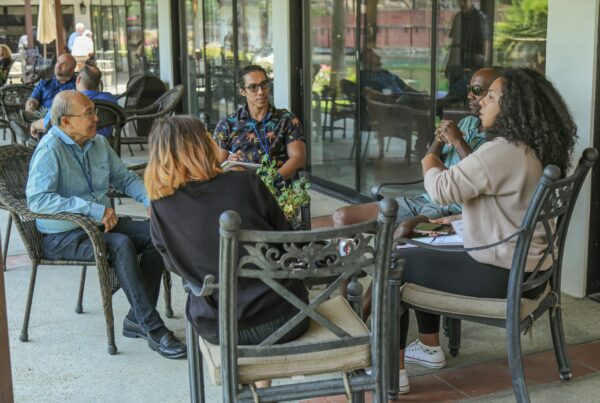W e all tell stories on a daily basis; some of us tell them better than others. You know what I mean. Perhaps you have a coworker who likes to share one detail too many or takes far too long to get to the point. Or perhaps there is a seven-year-old in your life whose accounts, while charming, meander down a path that’s hard to follow. Then there are those really good sagas we remember and want to re-hear or re-tell.
The four C’s of story structure
There are all different types of good stories, and whether or not a story is considered actually good might be a matter of opinion. However, while good stories may vary in topic or length, they typically consist of similar elements: characters and setting, a conflict, a climax, and a conclusion. We’ll call these the four C’s of story structure.
When sharing our testimonies, which are stories by another name, a similar structure may be employed. Whether we are sharing our stories in an Instagram caption, a longer blog post, or some other kind of narrative, we want to share our testimony in a way that flows well and connects with the reader or listener. And I use the term testimony somewhat loosely. By testimony, I mean a story of something the Lord has done in your life—testifying to his goodness. This could be your entire life story, but it could also be about something that occurred last month or last weekend.
I will use a story of my own as an example. First, we will start with the setting, letting the reader know where this story took place, what was happening then, and who the characters were. Then we will progress to the conflict where things are starting to go wrong. We move on to the climax. Note: this is not the end! This is where things are building up, and perhaps the situation looks hopeless. We all breathe a sigh of relief at the resolution of the climax and the conclusion of the story.
A personal example
A few years ago, my husband and I lived in Waco, Texas. He was in graduate school, working toward completing his Juris Doctor degree and MBA, and I was supporting the two of us—and our golden retriever/lab mix puppy—by working at an LED lighting company. We lived a typical grad school student existence. We rented a small apartment, we ate as cheaply as possible (occasionally splurging and splitting a bowl from Chipotle!), and we often enjoyed whatever free recreation we could find in the area.
Well, during the spring, two years into our time in Waco, the head investor of the lighting company decided to pull his funding and let everyone go to restructure. He gave us a one-week notice. I had just won “Employee of the Month” the day before; my prize was an Olive Garden gift card. My husband and I sat stunned in the restaurant, trying not to cry into our pasta. What were we going to do? I had only been out of college for a few years and was still in the process of learning skills and gaining work experience. My resume still seemed pityingly short.
I immediately got a job as a barista at a local coffee shop and started applying everywhere I possibly could. If I was remotely qualified for a role, I applied for it. In order not to slip into anxiety or despair at the mounting rejection letters, my husband and I looked up every Scripture we could find about trusting in the Lord. We wrote them down on 3×5” index cards and taped them up all over our living space. Basically, any time I started to worry, my eyes would find a card. We taped them on lamp shades, bathroom mirrors, doors, and kitchen cabinets.
By the end of the summer, I had three part-time jobs but no full-time job. I was running myself ragged but did not have the full-time paycheck to reflect my exhaustion. So, my husband and I prayed. We prayed I would find a full-time job by the end of the year. December rolled around, and I still didn’t have a full-time job. It was a pretty lean Christmas. The end of the year was in sight and there was still no full-time job on the horizon. We thought perhaps the Lord was going to answer our prayer in a different way than we expected, for his ways are higher than ours, after all. Even while trusting God, we were still discouraged.
And then, on December 31, I was offered not one, but two full-time jobs! The Lord answered our prayers. We asked for a full-time job by the end of year, and two of the companies I worked for part time offered me full-time positions. Neither came with a lavish paycheck, but it was amazing to have options. I took one of the offers, and we will forever point to that time in our lives as a time when we prayed, and the Lord heard us and answered.
Looking back, the elements are obvious, right? My husband and I are the characters, the conflict is when I was let go from my job, and the climax is when the end of the year loomed, but no job offer was on the horizon. Finally, the conclusion is when I was offered two full-time jobs.
Sharing your testimony
No matter where or how you are sharing your story, the set-up is similar. The elements you will use are the characters and setting, the conflict, the climax, and the conclusion.
Please keep in mind that a testimony is about what the Lord has done. So, while you are one of the main characters, the focus should always come back to the Lord. We live in a culture that likes to glorify individual achievement, which can lead us to believe that what we have and what we have achieved, we alone earned. The reality is that our stories should always point back to the Creator. He created all things, and he sustains all things (Isaiah 46:4). And I don’t mean for you to live with a faux sense of gratitude (#blessed). I mean, no matter the circumstances—richer or poorer, glamourous office job or working in the service industry—we can be content in all things because the Lord strengthens us (Philippians 4:10-13). It is important to share our stories! Our stories all refer back to the One who made us, and we share them not only to glorify God, but also to remind ourselves that he who created us will sustain us.
Lastly, when sharing our stories, we want to keep in mind how to best connect with the listener or reader. How do we draw the audience in? How do we make our stories relevant? Those are questions perhaps best addressed another time. But a good place to start is to practice. The more often we share what the Lord is doing in our lives, the easier it will become. So, remember the four C’s and start sharing your stories.
Lynn-Holly Wielenga
Lynn-Holly Wielenga holds a communications degree from Baylor University and is currently obtaining her MBA in communications. She lives in Tulsa, Oklahoma.



